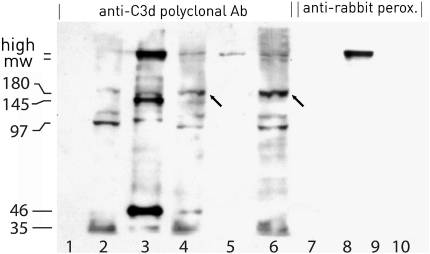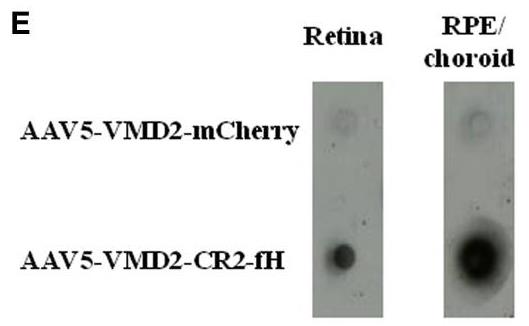CR2
-
Official Full Name
complement component (3d/Epstein Barr virus) receptor 2 -
Overview
CD21 is a 145 kD transmembrane protein, also known as complement C3d receptor (C3dR), complement receptor 2 (CR2), and Epstein-Barr virus receptor. CD21 is expressed on B cells, follicular dendritic cells, subsets of normal thymocytes and T cells, and som -
Synonyms
CR2;complement component (3d/Epstein Barr virus) receptor 2;complement receptor type 2;CD21;EBV receptor;complement C3d receptor;epstein-Barr virus receptor;CR;C3DR;SLEB9
Recombinant Proteins
- Human
- Mouse
- Rat
- Human Cell
- HEK293
- E.coli
- HEK293T
- Yeast
- StrepII
- His
- His&GST
- His&T7
- Non
- GST
- Myc&DDK
Background
What is CR2 protein?
CR2 gene (complement C3d receptor 2) is a protein coding gene which situated on the long arm of chromosome 1 at locus 1q32. CR2, also known as CD21, is a protein that in humans is encoded by the CR2 gene. It is a complement receptor 2 and part of the regulators of complement activation (RCA) family. CR2 is a receptor for the C3d component of the complement system, which is a part of the immune system that enhances the ability of antibodies and phagocytic cells to clear microbes and damaged cells from the body. By binding C3d, which is bound to an antigen, CR2 helps in the activation of B cells and the production of antibodies against the antigen. CR2 interacts with CD19 and CD81 to form a complex that amplifies B cell signaling, enhancing the immune response. The CR2 protein is consisted of 1033 amino acids and CR2 molecular weight is approximately 112.9 kDa.
What is the function of CR2 protein?
CR2, along with CD19 and CD81, forms a complex on the surface of B cells that acts as a co-receptor for the B cell receptor (BCR). This complex enhances B cell activation, proliferation, and differentiation in response to antigens. CR2 is involved in the clearance of immune complexes by binding to C3d-opsonized antigens and enhancing their uptake by phagocytic cells. As part of the regulators of complement activation (RCA) family, CR2 helps to regulate the complement system's activity to prevent excessive inflammation and damage to host tissues. Some viruses, such as Epstein-Barr virus (EBV), use CR2 as an entry receptor to infect B cells, highlighting its role in viral infection and pathogenesis.

Fig1. Schematic for the regulation of complement convertase activity within lymphatic tissue. (Amanda C Jacobson, 2008)
CR2 Related Signaling Pathway
CR2 acts as a co-stimulator of B cells, amplifying signals initiated by the BCR and leading to a more robust immune response. CR2 mediates the binding and internalization of immune complexes by B cells, facilitating the clearance of these complexes from the circulation. CR2 contributes to the regulation of complement activation to prevent damage to host cells and maintain immune homeostasis. CR2 interacts with other receptors on B cells, such as CD22, which can inhibit BCR signaling. The balance between activating and inhibitory signals helps to fine-tune B cell responses.
CR2 Related Diseases
Genetic variations in the CR2 gene are linked to an increased risk of developing autoimmune diseases such as Systemic Lupus Erythematosus (SLE), where the immune system mistakenly attacks the body's own tissues. CR2's role in the complement system and B cell activation means it can influence the body's response to infections. Some viruses, like Epstein-Barr Virus (EBV), use CR2 as an entry receptor to infect B cells, which can lead to diseases like infectious mononucleosis. Abnormalities in CR2 function may contribute to immunodeficiency conditions where the body is less able to fight off infections. CR2 may play a role in inflammatory diseases where the complement system's overactivation can cause tissue damage. Certain cancers, particularly those of B cell origin like some types of lymphomas, may involve dysregulation of CR2 and the complement system.
Bioapplications of CR2
CR2 is a crucial component in the study of the complement system and B cell activation, aiding in the understanding of immune responses and autoimmunity. Variants or changes in CR2 expression levels are investigated as potential biomarkers for certain diseases, particularly autoimmune conditions. Given its role in B cell activation and the pathogenesis of autoimmune diseases, CR2 is a target for therapeutic intervention, with potential treatments including monoclonal antibodies or small molecules to modulate its activity. CR2's function in the immune response makes it a candidate for enhancing vaccine efficacy by improving antigen presentation and B cell activation. The interaction of CR2 with the complement system and its role in pathogen entry (e.g., EBV) makes it a target for drug discovery to combat infections and modulate immune responses.
Case Study
Case Study 1: Giuseppe Barile, 2024
Reviewing old protocols, it was found that Raji, a CR2-posistive cell line, binds both endogenous (e-C3) and exogenous C3 (i-C3). The processing of i-C3 to an i-C3b-like protein and their fixation to CR2 isoforms resulted in the formation of heterodimers whose units might be linked via thioester by low m.w. molecule(s). In an attempt to study the origin of the low m.w. molecules, it was found that they were detected following I12⁵-C3d treatment with NHS or hi-S. Indirect evidence would suggest that the products of C3 fragment fixation could have a short half-life and that the aromatic residues present in C3d might have different physico-chemical characteristics than those present in C3c. The surface hydrophobicity expressed by these aromatic residues could be required for the fixation of C3 or CR2 fragments to cell surface proteins.

Fig1. The washed Raji cells were lysed and run under reducing condition on 7.5 % SDS-PAGE.

Fig2. Raji cells were treated PBS, OKB7 or HB5 for 30 min at 4 °C.
Case Study 2: Gloriane Schnabolk, 2017
Complement activation plays a significant role in age-related macular degeneration (AMD) pathogenesis, and polymorphisms interfering with factor H (fH) function, a complement alternative pathway (AP) inhibitor, are associated with increased AMD risk. Researchers have previously validated an AP inhibitor, a fusion protein consisting of a complement receptor 2 fragment linked to the inhibitory domain of fH (CR2-fH) as an efficacious treatment for choroidal neovascularization (CNV) when delivered intravenously. Here they tested an alternative approach of AAV-mediated delivery (AAV5-VMD2-CR2-fH or AAV5-VMD2-mCherry) using subretinal delivery in C57BL/6J mice. Secretion of CR2-fH was confirmed in polarized retinal pigment epithelium (RPE) cells. A safe concentration of AAV5-VMD2-CR2-fH was identified using electroretinography, optical coherence tomography (OCT), RPE morphology, and antibody profiling. OCT assessment demonstrated reduced CNV with AAV5-VMD2-CR2-fH administration.

Fig3. Using dot blot analysis staining for anti-CR2.

Fig4. Subretinal AAV5 Treatment Does Not Result in Systemic Response.
Quality Guarantee
High Purity
.jpg)
Fig1. SDS-PAGE (CR2-836H)
.
.jpg)
Fig2. SDS-PAGE (CR2-3258H)
Involved Pathway
CR2 involved in several pathways and played different roles in them. We selected most pathways CR2 participated on our site, such as B Cell Receptor Signaling Pathway,Complement and Coagulation Cascades,Epstein-Barr virus infection, which may be useful for your reference. Also, other proteins which involved in the same pathway with CR2 were listed below. Creative BioMart supplied nearly all the proteins listed, you can search them on our site.
| Pathway Name | Pathway Related Protein |
|---|---|
| Epstein-Barr virus infection | IKBKB,PIK3CB,HLA-DQA1,MAPK11,IFNG,HLA-DPA1,SYK,POLR2C,EIF2AK1,YWHAG |
| Complement and coagulation cascades | C1QA,VWF,C2,F13B,GM5077,FGG,CFB,PROS1,SERPING1,CFH |
| B Cell Receptor Signaling Pathway | RAF1,PPP3CA,IGHM,MAPK3,RASGRP3,BANK1,PIK3R2,BCL2L11,BCL10,RAC1 |
| Hematopoietic cell lineage | Fcer2a,IL1R1,GP9,IL7,CD38,GM2002,Il4ra,ITGA2,HLA-DRB3,IL1R2 |
Protein Function
CR2 has several biochemical functions, for example, DNA binding,complement binding,complement receptor activity. Some of the functions are cooperated with other proteins, some of the functions could acted by CR2 itself. We selected most functions CR2 had, and list some proteins which have the same functions with CR2. You can find most of the proteins on our site.
| Function | Related Protein |
|---|---|
| complement binding | C8A,C8G,CD46,CD59,CFB |
| protein homodimerization activity | HES1,NRBP1,TREX1,LGALS6,EEA1,ECT2,NR6A1A,SYT10,HEXB,RASGRP1 |
| transmembrane signaling receptor activity | GP6,CD300C,PTH1RA,Fzd4,NPC1,NRXN2,TLR6,TNFRSF10D,SEMA4D,TLR9 |
| DNA binding | OTX1A,SUPV3L1,RBPJB,HIST1H2B5,PIAS4,DNMT1,ZFP518A,NR6A1,KIF4,PROX1B |
| virus receptor activity | SELPLG,ANPEP,HSPA1B,SLC20A2,ITGB3,CD46,TNFRSF4,NCAM1,DPP4,ITGB5 |
Interacting Protein
CR2 has direct interactions with proteins and molecules. Those interactions were detected by several methods such as yeast two hybrid, co-IP, pull-down and so on. We selected proteins and molecules interacted with CR2 here. Most of them are supplied by our site. Hope this information will be useful for your research of CR2.
q8d0x0_yerpe
Resources
Research Area
Serine Proteases and RegulatorsB Cell Markers
B Cell Receptor-Associated Proteins
T Follicular Helper (Tfh) Cells
MDSC Phenotyping - Negative Markers
Related Services
Related Products
References
- Herrero, R; Real, LM; et al. Association of complement receptor 2 polymorphisms with innate resistance to HIV-1 infection. GENES AND IMMUNITY 16:134-141(2015).
- Mohan, RR; Gorham, RD; et al. A theoretical view of the C3d:CR2 binding controversy. MOLECULAR IMMUNOLOGY 64:112-122(2015).


